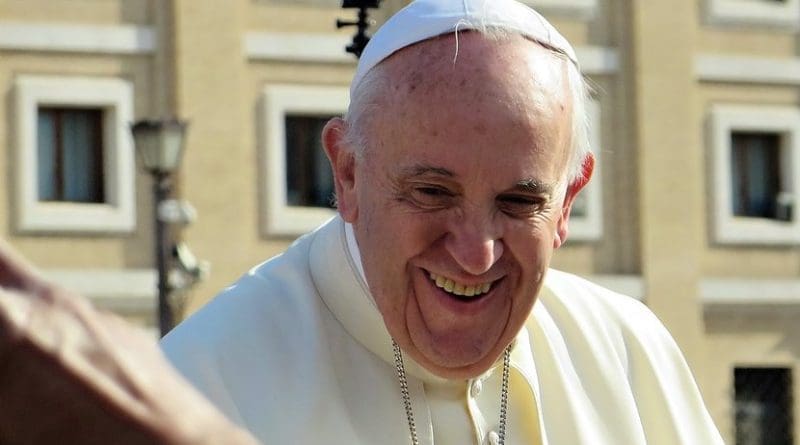Pope Francis To visit Thailand, Japan
By UCA News
Pope Francis is to visit Thailand in November in a major boost for the Catholic Church in the Buddhist-majority nation.
He has accepted an invitation from the Catholic Bishops’ Conference of Thailand to spend four days in the capital, Bangkok, from Nov. 20-23 before traveling to Japan.
Details of the visit were announced in a media statement on Sept. 13 from Archbishop Paul Tschang In-Nam, apostolic nuncio of the Holy See to the Kingdom of Thailand, and Cardinal Francis-Xavier Kriengsak Kovithavanij, president of the bishops’ conference.
According to the statement, Pope Francis is visiting Thailand as “a pilgrim of peace and to promote inter-religious dialogue.”
The visit will include the pope being received by the nation’s new king, His Majesty King Maha Vajiralongkorn.
Pope Francis will also conduct religious ceremonies and pastoral visits to Catholic communities in Thailand, which has a population of 69 million that includes 380,000 Catholics in 12 dioceses with 436 parishes and 662 priests.
He will be the second pope to visit the Southeast Asian nation following Pope St. John Paul II, who met King Bhumibol Adulyadej on May 10, 1984.
The announcement of the pope’s visit to Thailand follows months of media speculation and unconfirmed reports.
Pope Francis is due to visit Tokyo, Nagasaki and Hiroshima in Japan from Nov. 23-26 where he is expected to speak out against nuclear weapons.
Vatican’s Mission de Siam
The Catholic Church in Thailand is this year celebrating the 350th anniversary of the Vatican’s Mission de Siam, which began in 1669 during the papacy of Pope Clement IX.
This is also the 50th anniversary of the establishment of diplomatic relations between Thailand and the Holy See as well as the 35th anniversary of the first and also last papal visit to Thailand.
The statement from the bishops’ conference noted that there is historical evidence that Catholicism was first introduced to Siam (the former name of Thailand) by Dominican missionaries in 1567 when Ayutthaya was still the capital.
From 1669 onwards, missionaries and lay Catholics brought western technology and knowhow that supported national development while also being involved in numerous acts of charity for Catholics and non-Catholics alike, the official statement issued in Bangkok said.
“Throughout all this time, Catholics received the constant support of the monarchs of Thailand,” the statement added.
King Chulalongkorn the Great (Rama V) met Pope Leo XIII during his European tour of that time on June 4, 1897. His successor, King Prajadhipok (Rama VII), and Queen Rambai Barni met Pope Pius XI on March 21, 1934.
Finally, Their Majesties King Bhumibol Adulyadej and Queen Sirikit visited Vatican City and met Pope St. John XXIII on Oct. 3, 1963.
In 1984, His Majesty King Maha Vajiralongkorn, then the crown prince, personally welcomed Pope St. John Paul II at the Don Mueang Royal Thai Air Force Base and escorted him to a solemn audience with Their Majesties King Bhumibol Adulyadej, Queen Sirikit, and Her Royal Highness Princess Srinagarindra, the princess mother, at the Dusit Mahaprasat Throne Hall of the Grand Palace.
Later, Pope St. John Paul II met the Buddhist spiritual leader, His Holiness Ariyavangsagatayana VIII (Vasana Vasano), the 18th supreme patriarch of Thailand, at Wat Ratchabophit before conducting an open-air Mass at Supachalasai National Stadium.
The pontiff also visited refugee camps, Assumption Cathedral, a seminary and a hospital as well as attending a formal reception at Government House.
Message of peace in Japan
The theme of the pope’s visit to Japan will be “Protect All Life.” Archbishop Mitsuaki Takami of Nagasaki, president of the Catholic Bishops’ Conference of Japan, said: “I am grateful that he will come to Japan with its small number of Christians compared to other countries.”
The Catholic population in Japan is roughly 440,000, only 0.35 percent of the whole population. However, that number does not include foreign Catholics in the country.
Archbishop Takami said Japanese bishops have taken and sent invitation letters to the pope since July 2014.
“In general audiences, the pope mentioned the Christian age of Japan and issued a photograph of a boy with the corpse of his baby brother following the atomic bombing of Nagasaki,” he said. “I suppose these words and actions of the pope implied his wish for this visit.”
The archbishop’s mother survived the atomic bombing of Nagasaki while she was carrying him in her womb.
Archbishop Isao Kikuchi of Tokyo said: “With great joy and gratitude, I, together with everyone in the archdiocese, welcome the Holy Father in our midst.”
In his statement, the Divine Word archbishop continued: “‘A church which goes forth’ is the attitude which the Holy Father shows as his image of the Church. We will follow his witness in words and deeds to realize such a church in Japan.”
Pope Francis’ detailed schedule in Japan has still not been announced. However, he is to visit Japan’s capital and the two atomic-bombed cities of Hiroshima and Nagasaki.
The pope will celebrate Masses in Nagasaki and Tokyo.
The last papal visit to Japan was made by Pope John Paul II in 1981. The Polish pope also visited Tokyo, Hiroshima and Nagasaki. He met then-emperor Hirohito in Tokyo, while at the Hiroshima Peace Memorial Park he made a strong appeal for peace to the world.

